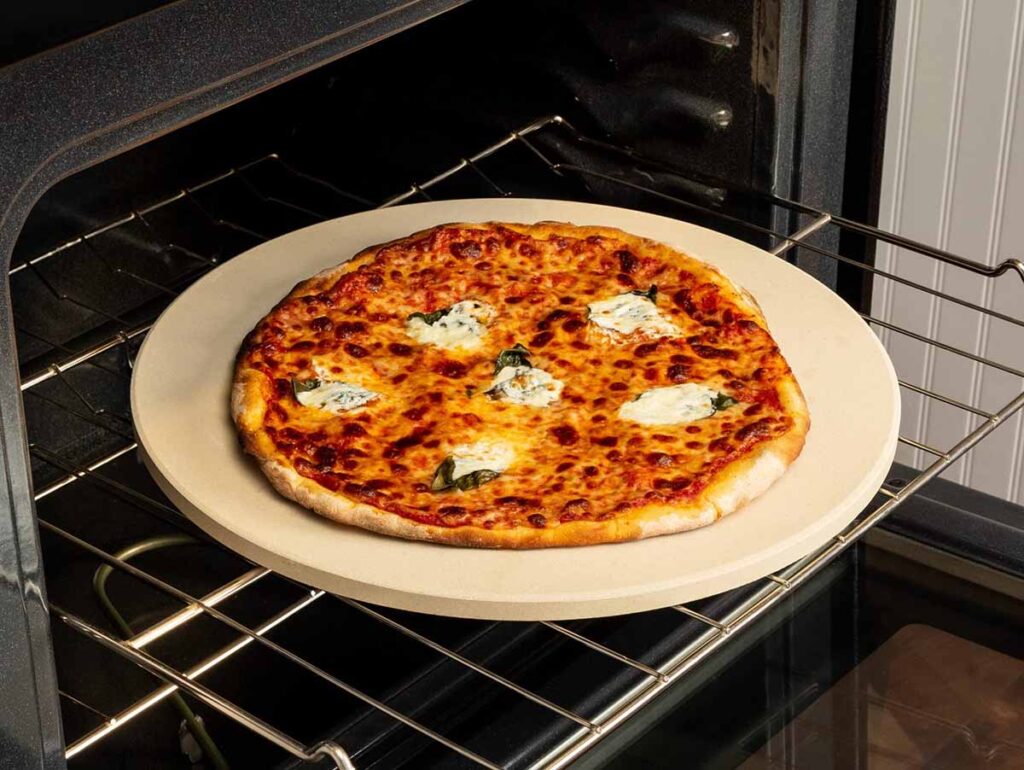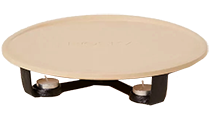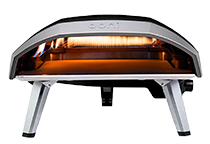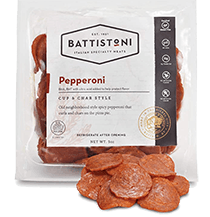Pizza stones have gained popularity among home chefs and pizza enthusiasts alike for their ability to replicate the delicious, crispy crust that comes from a traditional wood-fired oven. Understanding the thermal properties of a pizza stone is essential to get the most out of this kitchen tool.
One important aspect to consider is how long does a pizza stone stay hot, as it impacts both cooking time and the quality of your pizza.
A pizza stone can withstand very high temperatures, usually around 550º F (280°C). This heat is necessary for achieving that perfect crust, but it’s also important to know how long the stone retains this heat.
The pizza stone’s ability to maintain its temperature plays a crucial role in the cooking process, allowing your pizza to cook evenly and quickly. Generally, a well-heated pizza stone can stay hot for around an hour after being removed from the oven.
Key Takeaways
- Pizza stones help replicate wood-fired oven crusts
- They can withstand high temperatures of around 550º F (280°C)
- A well-heated pizza stone maintains its heat for approximately one hour after removal from the oven
Table of Contents

Understanding Pizza Stones
Material and Thickness
Pizza stones are typically made from materials like ceramic, cordierite, or pressed clay, which are able to withstand high temperatures. The thickness of a pizza stone can vary, but generally, they are between a 1/4-inch and a 1/2-inch thick. Thicker stones tend to retain heat better and provide a more even cooking surface for pizzas, resulting in a crispy crust.
The Role of Heat in Pizza Stones
The purpose of a pizza stone is to effectively mimic the conditions of a traditional brick oven in your home oven. The stone absorbs heat and retains it, making the surface incredibly hot, which in turn bakes the pizza quickly.
When baking a pizza on a pizza stone, we recommend preheating the stone in the oven at a high temperature, usually around 500-550°F (260-280°C). By preheating the stone, you ensure that it is hot enough to create that crispy crust. A pizza stone can stay hot for approximately an hour after being removed from the oven.
Using a pizza stone in the oven is an effective way to achieve a crispy crust while baking at home. The material and thickness of the stone play a key role in its ability to retain heat, which ultimately results in a perfect pizza every time.
Using a Pizza Stone
Steps to Preheat a Pizza Stone
To get the best results when using a pizza stone, we recommend these steps for preheating the stone:
- Place the stone in a cold oven: Position the pizza stone on an oven rack in the center of your oven. Starting with a cold oven ensures that your stone will heat evenly.
- Preheat the oven: Set the oven temperature to the highest setting, typically around 500-550° F (260-280° C). Allow the oven to preheat for at least 30 minutes to ensure the stone reaches its optimal temperature.
- Prepare the pizza: While the oven is preheating, shape your pizza dough and add your desired toppings. Be sure to use a well-floured surface to prevent the dough from sticking to the stone.
Cooking with a Pizza Stone
Once your oven and stone have reached their ideal temperatures, carefully transfer your homemade pizza to the hot stone.
- Use a pizza peel: The easiest way to transfer the pizza to the stone is using a pizza peel. Slide the peel under the dough, then gently slide the pizza onto the stone.
- Bake the pizza: Allow the pizza to bake for 8-12 minutes, depending on the thickness of the dough and your desired crispiness.
- Monitor the pizza: Keep an eye on your pizza while it bakes, as the high heat can cause it to cook quickly. Turn the pizza 180 degrees halfway through the baking process to ensure even cooking.
- Remove the pizza: Once your pizza is cooked to your liking, use a pizza peel or spatula to carefully remove it from the stone
Keep in mind that a pizza stone stays hot for approximately an hour after being removed from the oven, so let it cool down before handling or cleaning it. A well-seasoned stone will not only enhance the flavor of your pizza but also make it easier to work with over time.
Benefits of Pizza Stones
Texture and Taste
Using a pizza stone offers numerous advantages in terms of texture and taste. Firstly, it provides a crispy crust by absorbing moisture from the dough while cooking, leaving the desired crunch on the outside while still maintaining a moist interior. This prevents the occurrence of a soggy crust, which is often a common issue with cooking pizza on a regular baking sheet.
The even heat distribution of the stone ensures that the crust is cooked uniformly, enabling consistency in both texture and taste. In addition, a hot pizza stone promotes air circulation beneath the pizza, further adding to the crispiness of the crust. This effect is particularly important for Neapolitan-style pizzas, which are known for their thin and crispy crusts.
Temperature Regulation
Pizza stones are exceptional at retaining and regulating heat. Preheating the stone at high temperatures of around 500-550° F (260-280° C) for about an hour will allow it to absorb and hold the heat. This not only assists in achieving a well-browned crust but also maintains the temperature in the oven when the door is opened to insert or remove the pizza. As a result, the cooking process is not interrupted, and the pizza continues to cook evenly.
Apart from pizzas, stones can also be used for other types of bread, enhancing their texture and taste. When using a pizza stone as a serving plate, its heat retaining property helps keep the food warm longer.
Remember to use a layer of cornmeal, semolina, or parchment paper between the stone and the pizza to prevent it from sticking to the surface. Enjoy the delicious and authentic pizza experience with the help of a high-quality pizza stone!

Maintenance and Care
Avoiding Thermal Shock
One of the critical aspects of maintaining a pizza stone is to avoid thermal shock. Thermal shock occurs when the stone is exposed to sudden temperature changes, which can lead to cracks and damage. To prevent this, always preheat your pizza stone, along with your oven or grill, for at least 20-30 minutes before placing any pizza or flatbread on it.
When you’re done cooking, avoid placing the hot pizza stone on your cutting board or cold surfaces, as this can also cause thermal shock. Instead, let the pizza stone cool down on a heat-resistant surface for at least an hour before handling or cleaning it. While using the stone, also ensure not to expose it to any liquids or cold pizza toppings, as this can cause sudden temperature fluctuations.
Cleaning Your Pizza Stone
To clean your pizza stone, it’s important to understand that this unique kitchen tool actually accumulates flavors over time due to trace stains that build up. These stains don’t harm the stone, so you don’t want to interfere with its seasoning process by using soap or any other cleaning agents, as they can break down these flavors and even soak into the stone’s porous surface.
Here’s a simple process for cleaning your pizza stone:
- Let the pizza stone cool completely before cleaning to avoid the risk of thermal shock or burns.
- Scrape off any remaining food debris, such as cheese, sauce, or pizza toppings, with a flat-edged spatula or a scraper designed for use with pizza stones.
- For more stubborn stains, you can use a cleaning solution made from salt or baking soda mixed with a small amount of water. Gently scrub the mixture onto the pizza stone using a soft-bristle brush or cloth, being careful not to damage its surface.
- After cleaning, thoroughly dry your pizza stone by allowing it to air dry or by gently wiping it with a clean microfiber cloth. If possible, let the stone dry in a warm oven to evaporate any residual moisture completely.
By following these simple guidelines for avoiding thermal shock and properly cleaning your pizza stone, our valued kitchen companion will stay in great shape and deliver consistent, delicious results for many years. Remember, a well-maintained pizza stone is not just a durable and reliable cooking surface, but also a testament to the flavorful memories we create in our home kitchens.
Beyond Pizza: Other Uses for Pizza Stones
While pizza stones are primarily known for their ability to create perfectly crispy and evenly cooked pizzas, they can also be used for a variety of other dishes. Here are two additional ways to utilize your pizza stone:
Baking Breads and Flatbreads
Pizza stones can be used to bake breads and flatbreads, giving them a crispy crust and even cooking. Simply preheat your pizza stone in the oven and then place your bread or flatbread on top. The heat from the stone will help to evenly distribute the heat, ensuring that your bread or flatbread is cooked to perfection.
Roasting and Searing
Pizza stones can also be used for roasting and searing meats and vegetables. By placing your meat or vegetables directly on the pizza stone, you can achieve a crispy and evenly cooked exterior, while still maintaining a juicy and tender interior. This method of cooking is particularly effective for steaks, chicken, and fish.
In conclusion, pizza stones are a versatile tool that can be used for a variety of cooking techniques beyond just making pizza. Whether you’re baking breads and flatbreads or roasting and searing meats and vegetables, a pizza stone can help you achieve perfectly cooked and delicious results. So, if you don’t already have a pizza stone in your kitchen, it’s definitely worth considering adding one to your cooking arsenal.
Frequently Asked Questions
What is the ideal temperature for using a pizza stone?
The ideal temperature for using a pizza stone is around 500-550° F (260-290° C). This high temperature allows the pizza to cook quickly and evenly, while also creating a crispy crust. It’s important to preheat the stone for at least 30 minutes before placing the pizza on it to ensure that it reaches the desired temperature.
Additionally, it’s recommended to use a pizza peel or parchment paper to transfer the pizza onto the hot stone to avoid any accidents or sticking. With a properly heated pizza stone, you can achieve restaurant-quality pizza in the comfort of your own home.
How long should you preheat a pizza stone before using it?
You should preheat a pizza stone for at least 30 minutes before using it. This allows the stone to fully heat up and reach the desired temperature, which is typically around 500-550°F (260-290°C) for the best results. Preheating the stone also helps to ensure that the pizza cooks evenly and results in a crispy crust.
It’s important to note that the preheating time may vary depending on the size and thickness of the pizza stone, as well as the type of oven being used. It’s always a good idea to consult the manufacturer’s instructions for specific preheating recommendations.
Do you need to oil a pizza stone before baking?
Yes, it is recommended to oil a pizza stone before baking. Apply a thin layer of cooking oil, such as olive oil, onto the surface of the pizza stone to prevent the dough from sticking and to help achieve a crisp crust. There are also multiple ways to season a pizza stone.
What are the proper steps for using a pizza stone for the first time?
1. Preheat your oven: Place the pizza stone on the middle rack of your oven and preheat it to the desired temperature (usually around 500° F or 260° C) for at least 30 minutes to ensure it reaches its maximum heat retention.
2. Prepare the pizza dough: While the oven is preheating, prepare your pizza dough according to your recipe or the pizza crust instructions. Roll out the dough into your desired thickness and shape.
3. Transfer the dough to the pizza stone: Once the oven and the pizza stone are preheated, carefully remove the stone from the oven using oven mitts or heat-resistant gloves. Place the rolled-out dough onto a pizza peel or a flat surface dusted with flour or cornmeal to prevent sticking. This will make it easier to transfer the pizza onto the hot stone.
4. Add toppings: Once the dough is on the pizza peel or flat surface, add your desired pizza sauce, cheese, and toppings. Be creative with your favorite toppings!
5. Transfer the pizza to the hot stone: Carefully slide the pizza from the peel or flat surface onto the preheated pizza stone in the oven. Be cautious not to touch the hot stone to prevent burns.
6. Bake the pizza: Close the oven door and allow the pizza to bake for the recommended time specified in your recipe or until the crust is golden brown and the cheese is melted and bubbly.
7. Remove the pizza from the stone: Once the pizza is fully cooked, use the pizza peel or a large spatula to carefully remove it from the hot stone. Place the pizza on a cutting board or serving platter.
8. Allow the stone to cool: After removing the pizza, turn off the oven and let the pizza stone cool down inside the oven. Avoid placing the hot stone directly on a cool surface, as it may crack.
Note: It’s essential to read the manufacturer’s instructions for your specific pizza stone, as some stones may have unique care and usage instructions.
How do you safely cool down a pizza stone after use?
Allow the pizza stone to cool naturally at room temperature. Do not expose it to rapid temperature changes or use water to cool it down, as this can cause it to crack.
Is a pizza stone effective for keeping food warm?
Yes, a pizza stone can help in keeping food warm. Its ability to retain heat can help to maintain the temperature of the food for a longer duration. But keep in mind it won’t stay warm forever on its own.
How long does a pizza stone stay hot?
A pizza stone can stay hot for a significant amount of time after being removed from the oven. It can take anywhere from 30 minutes to several hours for a pizza stone to cool down completely.













